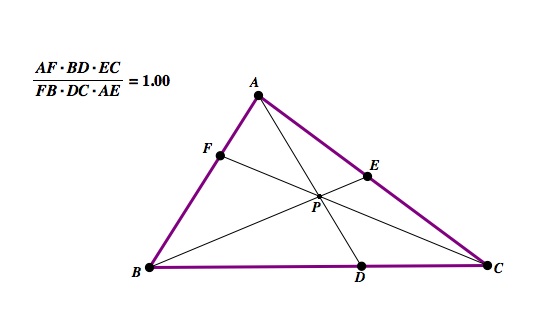

We are given a triangle ∆ABC with an arbitrary point P inside the triangle. Any segment from a vertex to the intersection with the opposite side is called a Cevian. Let D, E, and F be the feet of the Cevians opposite A, B, and C respectively. If the three Cevians AD, BE, and CF are concurrent at P, then prove
.
We are going to prove the ratio above is true by using the ratio of areas of triangles within ∆ABC. The converse of this conjecture will then be proved. We have below segments AD, BE, and CF all of which are concurrent through the point P as given. The beauty of Ceva's Theorem is not only that the ratio above is true, but the ratio always holds true no matter where P lies within the triangle.

We are going to prove if the lines AD, BE, and CF are concurrent then the ratio above holds true. Let's begin with the area of two sub-triangles and see if we can find a ratio of segments.
Ah ha! Yes, the ratios worked above give us the ratio of DB/DC, which is exactly the start we need to complete the proof. If you do not see why the ratio of the sine angles equals one recall the fact that sin (180 - Θ) = sin (Θ) for any angle Θ and since the sum of our two angles sin (∠ADB) + sin (∠ADC) = 180 we can safely say their ratio equals 1. If we continue this strategy we find:
Notice each time we formed the ratio of areas we always used a Cevian in our Sine Area Formula: Area(∆ABC) = 1/2absin(∠γ) . This helped us narrow down which sides of the triangle we wanted to use to calculate the area. We knew we were going to have to cancel a few things so using a common leg came in handy!
So now we can say,

And now reworking the other subareas we find the following,


Therefore, because the Cevians AD, BE, and CF are concurrent and concur at point P we can say and have proved that
 .
.

Now, we must prove the converse. If the following ratio of side lengths is true

then the Cevians AD, BE, and CF are concurrent and concur at the point P.
Let's assume that AD and BE are Cevians and intersect at the point P. We want to show that CF also intersects AD and BE at point P. We know(AF)(BD)(CE)/(FB)(DC)(EA) = 1. And since we assumed AD and BE are Cevians we know (BD)(CE)(x)/ (DC)(EA)(y) = 1 there for we have

What happens when AF = FB and EC = AE and BD = DC? When these segments are equal in length we are saying that the sides a, b, and c of our triangle ABC have been split in two. Does our ratio still hold? It sure does! Therefore, if we again assume BD(CE)(x)/(DC)(EA)(Y) = 1 where AD and BE are Cevians and we want to prove CF is also a Cevian we come to the same conclusion as above. Except this time X = Y therefore our Cevians are not only Cevians but they are the medians of our triangle and still concurrent through the point P!
This concludes our exploration of Ceva's Theorem and ratio of areas. There are many more ways to prove this Theorem, but proving by areas of triangles requires you to look far beyond the walls of the triangle ABC.
CLICK HERE TO RETURN TO MY FINAL ASSIGNMENT PAGE